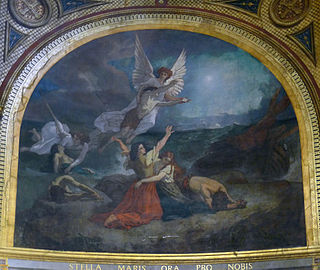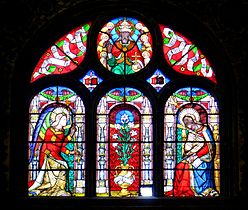Saint-Eustache, Paris
| Saint-Eustache, Paris | |
|---|---|
 Saint-Eustache from the south east | |
| Religion | |
| Affiliation | Catholic Church |
| Province | Archdiocese of Paris |
| Region | Île-de-France |
| Rite | Roman Rite |
| Status | Active |
| Location | |
| Location | 2 Impasse Saint-Eustache, 1er arr. |
| State | France |
| Geographic coordinates | 48°51′48″N 2°20′42″E / 48.86333°N 2.34500°ECoordinates: 48°51′48″N 2°20′42″E / 48.86333°N 2.34500°E |
| Architecture | |
| Type | Church |
| Style | French Gothic, French Renaissance, French classical |
| Groundbreaking | 1532 |
| Completed | 1633 |
| Direction of façade | West |
| Website | |
| www | |
The Church of St. Eustache, Paris (French: L’église Saint-Eustache) is a church in the 1st arrondissement of Paris. The present building was built between 1532 and 1632.
Situated near the site of Paris' medieval marketplace (Les Halles) and rue Montorgueil, Saint-Eustache exemplifies a mixture of multiple architectural styles: its structure is Gothic while its interior decoration[1] and other details are Renaissance and classical.
The 2019 Easter Mass at Notre-Dame cathedral in Paris was relocated to Saint-Eustache after the Notre-Dame de Paris fire.
History[]

Situated in Les Halles, an area of Paris once home to the country's largest food market, the origins of Saint Eustache date back to the 13th century. A modest chapel was built in 1213, dedicated to Saint Agnes, a Roman martyr.[2] The small chapel was funded by Jean Alais, a merchant at Les Halles who collected a tax on the sale of fish baskets as repayment of a loan to King Philippe-Auguste.[3] The church became the parish church of the Les Halles area in 1223 and was renamed Saint-Eustache in 1303.[4] The name of the church refers to Saint Eustace, a Roman general of the second century AD who was burned, along with his family, for converting to Christianity. The church was renamed for Saint Eustache after receiving relics related to the Roman martyr as donations from the Abbey of Saint Denis.[5]
Construction of the current church began in 1532 and continued until 1632, and in 1637, it was consecrated by Jean-François de Gondi, Archbishop of Paris.[6] Some of the architects associated with the church's construction include Pierre Lemercier,[7] his son Nicolas Lemercier,[8] and Nicolas' son-in-law Charles David.[9] The addition of two chapels in 1655 severely compromised the structural integrity of the church, necessitating the demolition of the facade, which was rebuilt in 1754 under the direction of the architect Jean Mansart de Jouy.[10]

During the French Revolution, the church was, like most churches in Paris, desecrated and looted. It was closed to Catholic worship in 1793 and used for a time as a barn; it was re-opened in 1795 with significant damage to the building and its furniture.[11] The building was further damaged by a fire in 1844.[12] Architect Victor Baltard directed a complete restoration of the building from 1846-1854, including the construction of the organ case, pulpit, and high altar and the repair of the church's paintings.[13] The church was set afire during the rule of the Paris Commune in 1871, necessitating repairs to the attic, buttresses, and south facade.[14][15] The facade was revised from 1928-1929.[16]
In 1969, the Halles de Paris market was relocated to Rungis, considerably modifying the neighborhood of the Church of St. Eustache.[17] Les Halles became a shopping center and hub for regional transportation, and the Church of St. Eustache remains a landmark of the area and a functioning church.[18]
Many celebrated Parisians are connected with the Church of St. Eustache. Louis XIV made his First Communion there in 1649.[19] Cardinal Richelieu, Jeanne-Antoinette Poisson (Madame de Pompadour), and Molière were all baptized there; Molière was also married there in 1662.[20] Mozart held his mother's funeral there.[21] Funerals were held at St. Eustache for Queen Anne of Austria, military hero Turenne, and French Revolution leader Mirabeau.[22] Writer Marie de Gournay was buried there.[23]
Architecture and Art[]

The church is an example of a Gothic structure clothed in Renaissance and classical detail.[24] Although the architects are unknown, similarities to designs used in the extension of the church of Saint-Maclou in Pontoise (begun in 1525) point to Jean Delamarre and/or Pierre Lemercier, who collaborated in that work.[25] The Italian-born architect Domenico da Cortona has also been suggested.[26] The church is relatively short in length at 105m, but its interior is 33.45m high to the vaulting.[27] At the main façade, the left tower has been completed in Renaissance style, while the right tower remains a stump. The front and rear aspects provide a remarkable contrast between the comparatively sober classical front and the exuberant rear, which integrates Gothic forms and organization with Classical details. The L'écoute sculpture by Henri de Miller appears outside the church, to the south. A Keith Haring sculpture stands in a chapel of the church.
The church contains a number of significant works of art in a variety of media and styles.
Chapel of the Virgin[]

The Chapel of the Virgin was built in 1640 and restored from 1801 to 1804. It was inaugurated by Pius VII on the 22nd of December, 1804 when he came to Paris for the coronation of Napoleon.[28]
The apse chapel, with a ribbed cul-de-four vault, has at its centre a sculpture of the Virgin and Child of Jean-Baptiste Pigalle that the painter Thomas Couture highlighted by three large paintings on the themes:
- Paintings of the Chapel of the Virgin

Left panel: "The Virgin of the star sailors"

"Central panel: "The triumphant Virgin adored by angels"

Right panel: "The Virgin comforting the afflicted"
Chapel des Charcutiers (Chapel of the Butchers)[]
As a marketplace church, St. Eustache represented not only its individual parishioners but trade groups as well. The Corporation des Charcutiers, which acts as the pork butchers' professional body, has been a significant patron of the church since the 17th century, and the group's special relationship with the church is represented in the Chapel des Charcutiers.[29] This chapel contains pork butchery depicted in stained glass as well as a contemporary work by John Armleder.[30]
Other Art[]
The Mausoleum of Colbert by Coysevox sits to the left of the Chapel of the Virgin. The best-known painting in St. Eustache is "The Disciples of Emmaus" by Rubens. The chapel of St. Madeleine holds "Ecstasy of the Madeleine" by Manetti. The chapel of St. Vincent de Paul contains "The Life of Christ" by Keith Haring. Another chapel contains "The Angel Leading Tobias" by Santi di Tito.[31]
Stained glass[]

Education of Louis IX (St. Louis Chapel)



Glass of the south transept
Glass of the north transept
Organ[]

With nearly 8,000 pipes, the great organ, with 101 stops and 147 ranks of pipes, is one of the largest organs in France, competing for first place with the great organ of Notre Dame de Paris, with 115 stops and 156 ranks of pipes, and that of Saint Sulpice, with 102 stops and 135 ranks of pipes.[32] The organ, originally constructed by P.-A. Ducroquet, was powerful enough for the premiere of Hector Berlioz's titanic Te Deum to be performed at St-Eustache in 1855. It was later modified under the direction of Joseph Bonnet. The present organ of St. Eustache was designed by Jean-Louis Coignet under the direction of Titular Organist Jean Guillou and dates from 1989, when it was almost entirely rebuilt by Dutch firm van Den Heuvel, retaining a few ranks of pipes from the former organ and the wooden case, which is original. Each summer, organ concerts commemorate the premieres of Berlioz’s Te Deum and Liszt’s Christus here in 1886.
|
|
| |||||||||||||||||||||||||||||||||||||||||||||||||||||||||||||||||||||||||||||||||||||||||||||||||||||||||||||||||||||||||||||||||||||||||||||||||||||||||||||||||||||||||||||||||||||||||||||||||||||||||||||||||||||||||||
Other burials[]

- Scaramouche (Tiberio Fiorelli), Italian comic actor
- Jean-Baptiste Colbert, Finance Minister
- Jean-Philippe Rameau, Composer
- Susan Feilding, Countess of Denbigh, English courtier
- Anna Maria Mozart, mother of Wolfgang Amadeus Mozart
Access[]
| Located near the Métro station: Les Halles. |
See also[]
References[]
Notes
- ^ "Patrimoine artistique - Eglise Saint Eustache". Eglise Saint Eustache (in French). Retrieved 2020-04-16.
- ^ "Paroisse Saint-Eustache - Histoire et Patrimoine". Eglise Saint Eustache (in French). Retrieved 2018-11-16.
- ^ "Saint-Eustache". www.nicolaslefloch.fr. Retrieved 2018-11-16.
- ^ "Saint-Eustache". www.nicolaslefloch.fr. Retrieved 2018-11-16.
- ^ "Histoire de l'église". Eglise Saint Eustache (in French). Retrieved 2018-11-16.
- ^ "Paroisse Saint-Eustache - Histoire et Patrimoine". Eglise Saint Eustache (in French). Retrieved 2018-11-16.
- ^ Sturgis, Russell (1901). A Dictionary of Architecture and Building, Volume II. New York: Macmillan. p. 738.
- ^ Sturgis, Russell (1901). A Dictionary of Architecture and Building, Volume II. New York: Macmillan. p. 739.
- ^ Sturgis, Russell (1901). A Dictionary of Architecture and Building, Volume I. New York: Macmillan. p. 749.
- ^ "Histoire de l'église". Eglise Saint Eustache (in French). Retrieved 2018-11-16.
- ^ "Histoire de l'église". Eglise Saint Eustache (in French). Retrieved 2018-11-16.
- ^ "Saint-Eustache". www.nicolaslefloch.fr. Retrieved 2018-11-16.
- ^ "Histoire de l'église". Eglise Saint Eustache (in French). Retrieved 2018-11-16.
- ^ "Saint-Eustache". www.nicolaslefloch.fr. Retrieved 2018-11-16.
- ^ "Histoire de l'église". Eglise Saint Eustache (in French). Retrieved 2018-11-16.
- ^ "Histoire de l'église". Eglise Saint Eustache (in French). Retrieved 2018-11-16.
- ^ "Rungis Market over time - Rungis Market". Rungis Market. Retrieved 2018-11-16.
- ^ "Histoire de l'église". Eglise Saint Eustache (in French). Retrieved 2018-11-16.
- ^ "Histoire de l'église". Eglise Saint Eustache (in French). Retrieved 2018-11-16.
- ^ Goldsby, Robert W. (2012-04-01). Molière on Stage: What's So Funny?. Anthem Press. ISBN 9780857289421.
- ^ "Histoire de l'église". Eglise Saint Eustache (in French). Retrieved 2018-11-17.
- ^ "Histoire de l'église". Eglise Saint Eustache (in French). Retrieved 2018-11-17.
- ^ "Marie DE GOURNAY : Biographie, Tombe, Citations, Forum... - JeSuisMort.com". JeSuisMort.com (in French). Retrieved 2018-11-17.
- ^ "Patrimoine artistique - Eglise Saint Eustache". Eglise Saint Eustache (in French). Retrieved 2018-11-17.
- ^ Ayers 2004, p. 52.
- ^ Fletcher, Banister and Palmes, J. C. A History of Architecture Charles Scribner's Sons, 1975. ISBN 0-684-14207-4, p. 908
- ^ "Patrimoine artistique - Eglise Saint Eustache". Eglise Saint Eustache (in French). Retrieved 2018-11-17.
- ^ "Patrimoine artistique - Eglise Saint Eustache". Eglise Saint Eustache (in French). Retrieved 2018-11-17.
- ^ "The Sausage Stained Glass of the Eglise Saint Eustache". Atlas Obscura. Retrieved 2018-11-17.
- ^ "Patrimoine artistique - Eglise Saint Eustache". Eglise Saint Eustache (in French). Retrieved 2018-11-17.
- ^ "Patrimoine artistique - Eglise Saint Eustache". Eglise Saint Eustache (in French). Retrieved 2018-11-17.
- ^ Le grand orgue, description in French at https://fr.wikipedia.org/wiki/%C3%89glise_Saint-Eustache_de_Paris#Le_grand_orgue
Sources
- Ayers, Andrew (2004). The Architecture of Paris. Stuttgart: Axel Menges. ISBN 9783930698967.
- A.-M. Sankovitch, The Church of Saint-Eustache in the Early French Renaissance (= Architectura Moderna, 12), Turnhout, 2015 (ISBN 978-2-503-55514-0)
External links[]
| Wikimedia Commons has media related to Église Saint-Eustache de Paris. |
- Gothic architecture in Paris
- 17th-century Roman Catholic church buildings in France
- Roman Catholic churches completed in 1632
- Roman Catholic churches in the 1st arrondissement of Paris
- 1632 establishments in France










